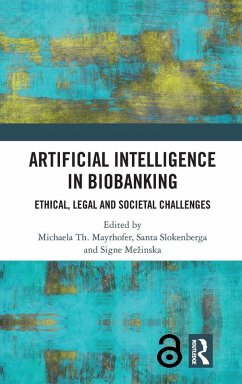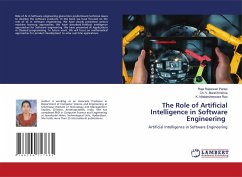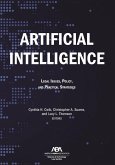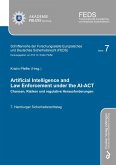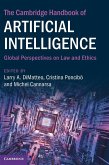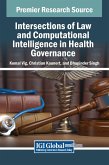Artificial Intelligence in Biobanking
Ethical, Legal and Societal Challenges
Herausgeber: Mayrhofer, Michaela Th.; Me¿inska, Signe; Slokenberga, Santa
Artificial Intelligence in Biobanking
Ethical, Legal and Societal Challenges
Herausgeber: Mayrhofer, Michaela Th.; Me¿inska, Signe; Slokenberga, Santa
- Gebundenes Buch
- Merkliste
- Auf die Merkliste
- Bewerten Bewerten
- Teilen
- Produkt teilen
- Produkterinnerung
- Produkterinnerung
This insightful collection highlights the ethical, legal and societal issues associated with the increasing role played by artificial intelligence (AI) in medical biobanks, a key research resource in the global study of disease prevention and the improving of individual care.
Andere Kunden interessierten sich auch für
![The Role of Artificial Intelligence in Software Engineering The Role of Artificial Intelligence in Software Engineering]() Raja Rajeswari PerepiThe Role of Artificial Intelligence in Software Engineering18,99 €
Raja Rajeswari PerepiThe Role of Artificial Intelligence in Software Engineering18,99 €![Moral Responsibility and Artificial Intelligence Moral Responsibility and Artificial Intelligence]() Maximilian KienerMoral Responsibility and Artificial Intelligence109,99 €
Maximilian KienerMoral Responsibility and Artificial Intelligence109,99 €![Artificial Intelligence Artificial Intelligence]() Artificial Intelligence103,99 €
Artificial Intelligence103,99 €![Artificial Intelligence - The Practical Legal Issues - 2nd Edition Artificial Intelligence - The Practical Legal Issues - 2nd Edition]() John BuyersArtificial Intelligence - The Practical Legal Issues - 2nd Edition51,99 €
John BuyersArtificial Intelligence - The Practical Legal Issues - 2nd Edition51,99 €![ARTIFICIAL INTELLIGENCE AND LAW ENFORCEMENT UNDER THE AI-ACT ARTIFICIAL INTELLIGENCE AND LAW ENFORCEMENT UNDER THE AI-ACT]() ARTIFICIAL INTELLIGENCE AND LAW ENFORCEMENT UNDER THE AI-ACT39,27 €
ARTIFICIAL INTELLIGENCE AND LAW ENFORCEMENT UNDER THE AI-ACT39,27 €![The Cambridge Handbook of Artificial Intelligence The Cambridge Handbook of Artificial Intelligence]() The Cambridge Handbook of Artificial Intelligence175,99 €
The Cambridge Handbook of Artificial Intelligence175,99 €![Intersections of Law and Computational Intelligence in Health Governance Intersections of Law and Computational Intelligence in Health Governance]() Intersections of Law and Computational Intelligence in Health Governance270,99 €
Intersections of Law and Computational Intelligence in Health Governance270,99 €-
-
-
This insightful collection highlights the ethical, legal and societal issues associated with the increasing role played by artificial intelligence (AI) in medical biobanks, a key research resource in the global study of disease prevention and the improving of individual care.
Produktdetails
- Produktdetails
- Verlag: Routledge
- Seitenzahl: 246
- Erscheinungstermin: 7. August 2025
- Englisch
- Abmessung: 240mm x 161mm x 18mm
- Gewicht: 537g
- ISBN-13: 9781032619927
- ISBN-10: 1032619929
- Artikelnr.: 74064778
- Herstellerkennzeichnung
- Libri GmbH
- Europaallee 1
- 36244 Bad Hersfeld
- gpsr@libri.de
- Verlag: Routledge
- Seitenzahl: 246
- Erscheinungstermin: 7. August 2025
- Englisch
- Abmessung: 240mm x 161mm x 18mm
- Gewicht: 537g
- ISBN-13: 9781032619927
- ISBN-10: 1032619929
- Artikelnr.: 74064778
- Herstellerkennzeichnung
- Libri GmbH
- Europaallee 1
- 36244 Bad Hersfeld
- gpsr@libri.de
Michaela Th. Mayrhofer is a political scientist, historian, and sociologist specializing in the governance of life sciences. She is founder of Papillon Pathways e.U. and the lead of ELSI at the Medical University of Innsbruck, Institute of Human Genetics, both Austria. Michaela has served as Head of ELSI Services & Research Department (2019-2025) and Co-Interim Director General (2020) at BBMRI-ERIC, Austria. She is a review editor for Frontiers in Digital Health, as well as an independent ethics advisor to several consortia and organizations, and a research ethics expert for the European Commission. Santa Slokenberga is an associate professor in medical law and a senior lecturer in administrative law at the Faculty of Law, Uppsala University, Sweden. She is a board member of the Nordic Permed Law Network and the European Association of Heath Law, as well as an independent ethics advisor to several consortia and organizations. Signe Meinska is a bioethicist and sociologist specializing in biomedical research ethics and medical ethics. She leads a research group at the University of Latvia, focusing on ethical challenges in the development and application of biotechnologies and the protection of patients' and research participants' rights. Signe has served as an ethics expert for international organizations, including UNESCO's International Bioethics Committee, WHO, and the European Commission.
Introduction Peaking in the Blackbox of AI and Its Many Layers. Part 1:
Legal Frameworks of AI. 1 The Approach of EU Law to Tackling Statistical
Bias in Medicine. 2 Liability for Damages, AI, and Machine Learning for
Digital Pathology as New Challenges for Biobanks. Part 2: Between Risk and
Trust. 3.Unique Design-the Need for Individualized Models of Trust in
Biobanking AI. 4.A Possible Risk Governance Approach for AI in Health
Research and Biobanking. 5.Artificial Intelligence, Sex, and Gender: Hypes,
Hopes, and Potential Risks in Biobanking. Part 3: Communicating the
Unknown. 6.Fairness of an AI System in the Case of a Biobank of Images and
Imaging Biomarkers. 7.Artificial Intelligence and Communication with
Research Participants in the Process of Biobanking Human Biological
Material. 8.Tackling AI Transparency Concerns in Biomedical Research:
Bringing a Communication-Participatory Approach to the Conversation. Part
4: Embracing the Potentiality. 9.Social Acceptance of Artificial
Intelligence in Biobanking. 10.Biobank-based Research Employing AI
Techniques: Challenges for Research Ethics Committees. 11.Powerful AI:
Between Accountability and Potentiality. Conclusion. 12.Learnings from
Unboxing the Blackbox
Legal Frameworks of AI. 1 The Approach of EU Law to Tackling Statistical
Bias in Medicine. 2 Liability for Damages, AI, and Machine Learning for
Digital Pathology as New Challenges for Biobanks. Part 2: Between Risk and
Trust. 3.Unique Design-the Need for Individualized Models of Trust in
Biobanking AI. 4.A Possible Risk Governance Approach for AI in Health
Research and Biobanking. 5.Artificial Intelligence, Sex, and Gender: Hypes,
Hopes, and Potential Risks in Biobanking. Part 3: Communicating the
Unknown. 6.Fairness of an AI System in the Case of a Biobank of Images and
Imaging Biomarkers. 7.Artificial Intelligence and Communication with
Research Participants in the Process of Biobanking Human Biological
Material. 8.Tackling AI Transparency Concerns in Biomedical Research:
Bringing a Communication-Participatory Approach to the Conversation. Part
4: Embracing the Potentiality. 9.Social Acceptance of Artificial
Intelligence in Biobanking. 10.Biobank-based Research Employing AI
Techniques: Challenges for Research Ethics Committees. 11.Powerful AI:
Between Accountability and Potentiality. Conclusion. 12.Learnings from
Unboxing the Blackbox
Introduction Peaking in the Blackbox of AI and Its Many Layers. Part 1:
Legal Frameworks of AI. 1 The Approach of EU Law to Tackling Statistical
Bias in Medicine. 2 Liability for Damages, AI, and Machine Learning for
Digital Pathology as New Challenges for Biobanks. Part 2: Between Risk and
Trust. 3.Unique Design-the Need for Individualized Models of Trust in
Biobanking AI. 4.A Possible Risk Governance Approach for AI in Health
Research and Biobanking. 5.Artificial Intelligence, Sex, and Gender: Hypes,
Hopes, and Potential Risks in Biobanking. Part 3: Communicating the
Unknown. 6.Fairness of an AI System in the Case of a Biobank of Images and
Imaging Biomarkers. 7.Artificial Intelligence and Communication with
Research Participants in the Process of Biobanking Human Biological
Material. 8.Tackling AI Transparency Concerns in Biomedical Research:
Bringing a Communication-Participatory Approach to the Conversation. Part
4: Embracing the Potentiality. 9.Social Acceptance of Artificial
Intelligence in Biobanking. 10.Biobank-based Research Employing AI
Techniques: Challenges for Research Ethics Committees. 11.Powerful AI:
Between Accountability and Potentiality. Conclusion. 12.Learnings from
Unboxing the Blackbox
Legal Frameworks of AI. 1 The Approach of EU Law to Tackling Statistical
Bias in Medicine. 2 Liability for Damages, AI, and Machine Learning for
Digital Pathology as New Challenges for Biobanks. Part 2: Between Risk and
Trust. 3.Unique Design-the Need for Individualized Models of Trust in
Biobanking AI. 4.A Possible Risk Governance Approach for AI in Health
Research and Biobanking. 5.Artificial Intelligence, Sex, and Gender: Hypes,
Hopes, and Potential Risks in Biobanking. Part 3: Communicating the
Unknown. 6.Fairness of an AI System in the Case of a Biobank of Images and
Imaging Biomarkers. 7.Artificial Intelligence and Communication with
Research Participants in the Process of Biobanking Human Biological
Material. 8.Tackling AI Transparency Concerns in Biomedical Research:
Bringing a Communication-Participatory Approach to the Conversation. Part
4: Embracing the Potentiality. 9.Social Acceptance of Artificial
Intelligence in Biobanking. 10.Biobank-based Research Employing AI
Techniques: Challenges for Research Ethics Committees. 11.Powerful AI:
Between Accountability and Potentiality. Conclusion. 12.Learnings from
Unboxing the Blackbox

